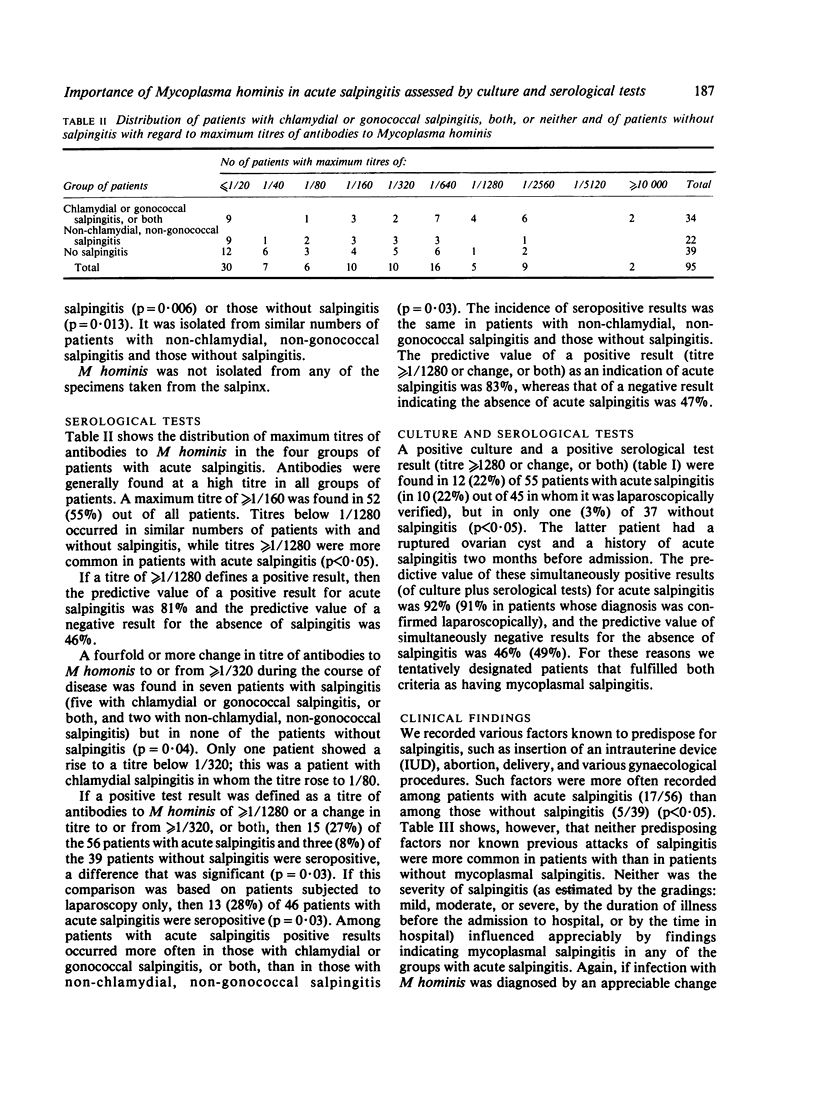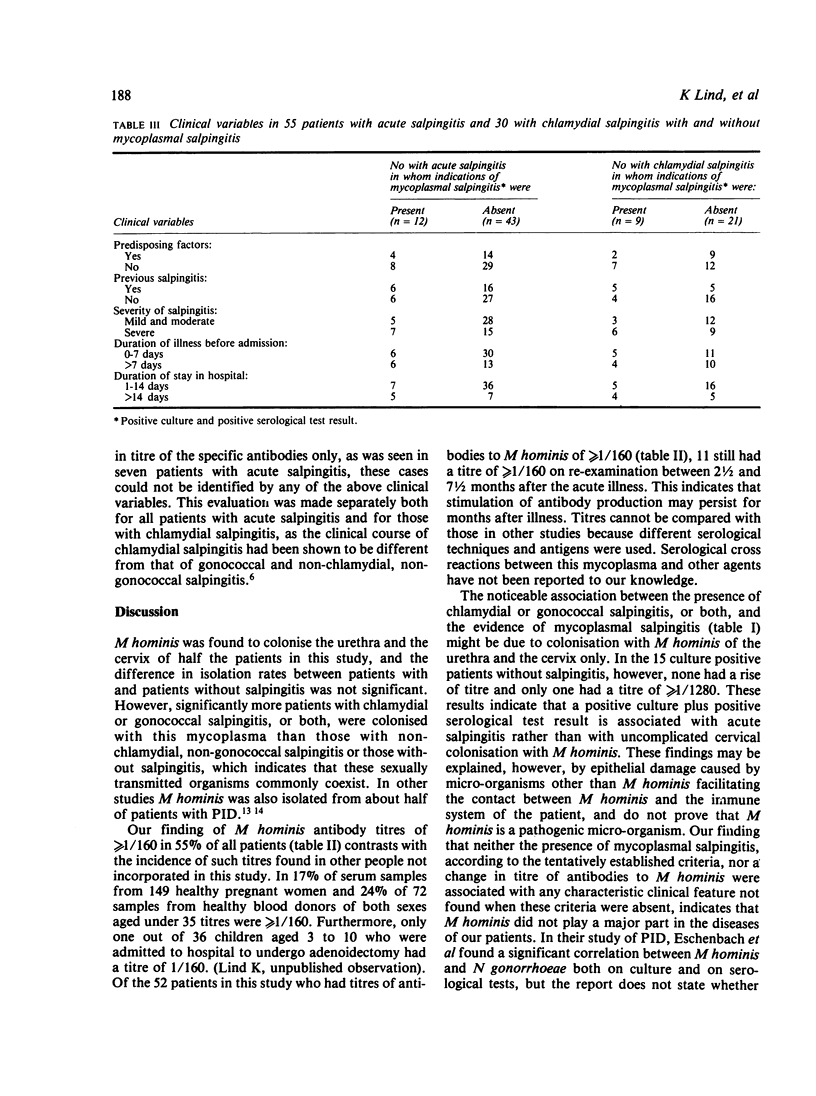Abstract
In 95 women with a provisional diagnosis of pelvic inflammatory disease, a final diagnosis of acute salpingitis was confirmed by laparoscopy in 46 and 10 had strong clinical evidence of acute salpingitis. The findings in the remaining 39 patients without signs of acute salpingitis by laparoscopy were used as a standard of reference. Criteria for the diagnosis of possible mycoplasmal salpingitis were tentatively defined as the isolation of Mycoplasma hominis from the cervix together with positive test results for M hominis antibodies (a titre of greater than or equal to 1/1280 or a change in titre, or both); these criteria were fulfilled in 12 patients with acute salpingitis. A positive correlation between mycoplasmal salpingitis and chlamydial salpingitis or gonococcal salpingitis, or both, was significant. Mycoplasmal salpingitis was not associated with any characteristic clinical feature different from those of patients with non-mycoplasmal salpingitis. Our findings do not support the view that M hominis is an important primary pathogen in acute salpingitis.
Full text
PDF




Selected References
These references are in PubMed. This may not be the complete list of references from this article.
- Cho H. J., Ruhnke H. L., Langford E. V. The indirect hemagglutination test for the detection of antibodies in cattle naturally infected mycoplasmas. Can J Comp Med. 1976 Jan;40(1):20–29. [PMC free article] [PubMed] [Google Scholar]
- Eschenbach D. A., Buchanan T. M., Pollock H. M., Forsyth P. S., Alexander E. R., Lin J. S., Wang S. P., Wentworth B. B., MacCormack W. M., Holmes K. K. Polymicrobial etiology of acute pelvic inflammatory disease. N Engl J Med. 1975 Jul 24;293(4):166–171. doi: 10.1056/NEJM197507242930403. [DOI] [PubMed] [Google Scholar]
- Hayflick L. Tissue cultures and mycoplasmas. Tex Rep Biol Med. 1965 Jun;23(Suppl):285+–285+. [PubMed] [Google Scholar]
- Holmes K. K., Eschenbach D. A., Knapp J. S. Salpingitis: overview of etiology and epidemiology. Am J Obstet Gynecol. 1980 Dec 1;138(7 Pt 2):893–900. doi: 10.1016/0002-9378(80)91078-9. [DOI] [PubMed] [Google Scholar]
- Kristensen G. B., Bollerup A. C., Lind K., Mårdh P. A., Ladehoff P., Larsen S., Marushak A., Rasmussen P., Rolschau J., Skoven I. Infections with Neisseria gonorrhoeae and Chlamydia trachomatis in women with acute salpingitis. Genitourin Med. 1985 Jun;61(3):179–184. doi: 10.1136/sti.61.3.179. [DOI] [PMC free article] [PubMed] [Google Scholar]
- Märdh P. A., Lind I., Svensson L., Weström L., Møller B. R. Antibodies to Chlamydia trachomatis, Mycoplasma hominis, and Neisseria gonorrhoeae in sera from patients with acute salpingitis. Br J Vener Dis. 1981 Apr;57(2):125–129. doi: 10.1136/sti.57.2.125. [DOI] [PMC free article] [PubMed] [Google Scholar]
- Mårdh P. A. An overview of infectious agents of salpingitis, their biology, and recent advances in methods of detection. Am J Obstet Gynecol. 1980 Dec 1;138(7 Pt 2):933–951. doi: 10.1016/0002-9378(80)91084-4. [DOI] [PubMed] [Google Scholar]
- Stanbridge E., Hayflick L. Growth inhibition test for identification of Mycoplasma species utilizing dried antiserum-impregnated paper discs. J Bacteriol. 1967 Apr;93(4):1392–1396. doi: 10.1128/jb.93.4.1392-1396.1967. [DOI] [PMC free article] [PubMed] [Google Scholar]
- Sweet R. L., Mills J., Hadley K. W., Blumenstock E., Schachter J., Robbie M. O., Draper D. L. Use of laparoscopy to determine the microbiologic etiology of acute salpingitis. Am J Obstet Gynecol. 1979 May 1;134(1):68–74. doi: 10.1016/0002-9378(79)90798-1. [DOI] [PubMed] [Google Scholar]
- Taylor-Robinson D., McCormack W. M. The genital mycoplasmas (first of two parts). N Engl J Med. 1980 May 1;302(18):1003–1010. doi: 10.1056/NEJM198005013021805. [DOI] [PubMed] [Google Scholar]
- Thompson S. E., 3rd, Hager W. D., Wong K. H., Lopez B., Ramsey C., Allen S. D., Stargel M. D., Thornsberry C., Benigno B. B., Thompson J. D. The microbiology and therapy of acute pelvic inflammatory disease in hospitalized patients. Am J Obstet Gynecol. 1980 Jan 15;136(2):179–186. doi: 10.1016/0002-9378(80)90592-x. [DOI] [PubMed] [Google Scholar]
- Weström L. Effect of acute pelvic inflammatory disease on fertility. Am J Obstet Gynecol. 1975 Mar 1;121(5):707–713. doi: 10.1016/0002-9378(75)90477-9. [DOI] [PubMed] [Google Scholar]


